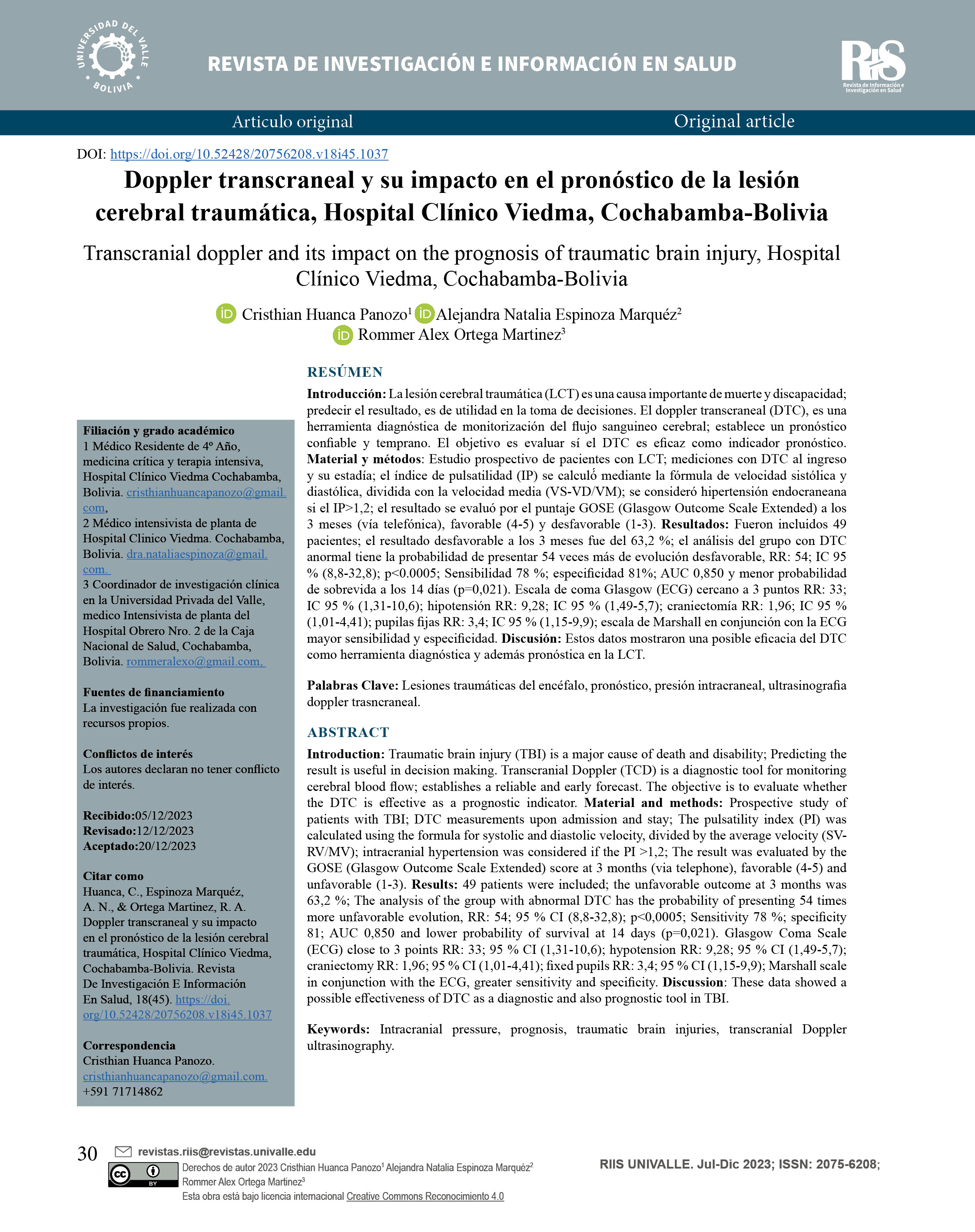Doppler transcraneal y su impacto en el pronóstico de la lesión cerebral traumática, Hospital Clínico Viedma, Cochabamba-Bolivia.
DOI:
https://doi.org/10.52428/20756208.v18i45.1037Palabras clave:
Lesiones traumátics del encéfalo, Pronóstico, Presión Intracraneal, Ultrasinografía Dopler transcranealResumen
Introducción: La lesión cerebral traumática (LCT) es una causa importante de muerte y discapacidad; predecir el resultado, es de utilidad en la toma de decisiones. El doppler transcraneal (DTC), es una herramienta diagnóstica y monitorización del flujo sanguineo cerebral; podría establecer un pronóstico confiable y temprano. El objetivo es evaluar sí las características del DTC es eficaz como indicador pronóstico. Material y métodos: Se realizó un estudio prospectivo de pacientes con LCT. Se efectuaron mediciones con DTC al ingreso y su estadía; el índice de pulsatilidad se calculó́ mediante la fórmula de velocidad sistólica y diastólica, dividida con la velocidad media (VS-VD/VM); se consideró hipertensión endocraneana si el índice de pulsatilidad (IP>1,2); el resultado se evaluó por el puntaje GOSE (Glasgow Outcome Scale Extended) a los 3 meses (información obtenida vía telefónica), dicotomizada: Favorable (4-5) y desfavorable (1-3). Resultados: Fueron incluidos 49 pacientes; el resultado desfavorable a los 3 meses fue del 63,2 %; el análisis del grupo con DTC anormal tiene la probabilidad de presentar 54 veces más de una evolución desfavorable (RR: 54; IC 95 % (8,8-32,8); p<0.0005); Sensibilidad 78 %; especificidad 81%; AUC 0,850, y menor probabilidad de sobrevida a los 14 días (p=0,021); variables independientes asociadas: Escala de coma Glasgow (ECG) cercano a 3 puntos RR: 33; IC 95 % (1,31-10,6); hipotensión RR: 9,28; IC 95 % (1,49-5,7); craniectomía RR: 1,96; IC 95 % (1,01-4,41); pupilas fijas RR: 3,4; IC 95 % (1,15-9,9); Escala de Marshall en conjunción con la ECG mayor sensibilidad y especificidad. Conclusión: Estos datos mostraron una posible eficacia del DTC como herramienta diagnóstica y además pronóstica en la lesión cerebral traumática.
Palabras Clave: Lesiones traumáticas del encéfalo, pronóstico, presión intracraneal, ultrasinografia doppler trasncraneal.
Descargas
Citas
Masson F, Thicoipe M, Mokni T. Epidemiology of traumatic coma: a prospective population-based study. Brain Inj 2010; 17:279-93. https://doi.org/10.1080/0269905021000030805
https://doi.org/10.1080/0269905021000030805 DOI: https://doi.org/10.1080/0269905021000030805
Cabrera A, Martínez O, Alejandro Ibarra A, Morales R, Laguna G, Sánchez M. Traumatismo craneoencefálico severo. Medicina Critica y Terapia Intensiva. 2009; 23(2):94-101. https://www.medigraphic.com/pdfs/medcri/ti-2009/ti092g.pdf
Nida F, Ashfaq Shuaib, Talat Saeed Chughtail, et al. The Role of Transcranial Doppler in Traumatic Brain Injury: A Systemic Review and Meta-Analysis. Asian Journal of Neurosurgery. 2019; 14(3): 626-633. https://www.ncbi.nlm.nih.gov/pmc/articles/PMC6702999/
https://doi.org/10.4103/ajns.AJNS_42_19 DOI: https://doi.org/10.4103/ajns.AJNS_42_19
Steyerberg EW, Mushkudiani N, Perel P, Butcher I, Lu J, McHugh GS, et al. Predicting outcome after traumatic brain injury: development and international validation of prognostic scores based on admission characteristics. PLoS Med 2008; 5(8):e165; discussion e16. https://doi.org/10.1371/journal.pmed.0050165
https://doi.org/10.1371/journal.pmed.0050165 DOI: https://doi.org/10.1371/journal.pmed.0050165
Bruns J Jr, Hauser WA. The epidemiology of traumatic brain injury: a review. Epilepsia 2003;44 Suppl 10:2-10. https://doi.org/10.1046/j.1528-1157.44.s10.3.x
https://doi.org/10.1046/j.1528-1157.44.s10.3.x DOI: https://doi.org/10.1046/j.1528-1157.44.s10.3.x
Butcher I, Maas AIR, Lu J, Marmarou A, Murray GD, Mushkudiani NA et al. Prognostic value of admission blood pressure in traumatic brain injury: results from the IMPACT study. J Neurotrauma 2007; 24: 294-302. https://doi.org/10.1089/neu.2006.0032
https://doi.org/10.1089/neu.2006.0032 DOI: https://doi.org/10.1089/neu.2006.0032
Tagliaferri F, Compagnone C, Korsic M, Servadei F, Kraus J. A systematic review of brain injury epidemiology in Europe. Acta Neurochir (Wien) 2006; 148: 255-68. https://doi.org/10.1007/s00701-005-0651-y
https://doi.org/10.1007/s00701-005-0651-y DOI: https://doi.org/10.1007/s00701-005-0651-y
Perel P, Arango M. CRASH. Trial Collaborators. Predicting outcome after traumatic brain injury: practical prognostic models based on large cohort of international patients. BMJ 2008; 336: 425-9. https://doi.org/10.1136/bmj.39461.643438.25
https://doi.org/10.1136/bmj.39461.643438.25 DOI: https://doi.org/10.1136/bmj.39461.643438.25
Mushkudiani NA, Engel DC, Steyerberg EW, Butcher I, Lu J, Marmarou A, et al. Prognostic value of demographic characteristics in traumatic brain injury: results from the IMPACT study. J Neurotrauma 2007; 24: 259-69. https://doi.org/10.1089/neu.2006.0028
https://doi.org/10.1089/neu.2006.0028 DOI: https://doi.org/10.1089/neu.2006.0028
Chacón-Lozsán F, et al. Neuromonitorización hemodinámica por ultrasonido en el paciente crítico: ultrasonido transcraneal. Acta Colomb Cuid Intensivo. 2018. https://www.medigraphic.com/cgi-in/new/resumen.cgi?IDARTICULO=111409
https://doi.org/10.1016/j.acci.2018.01.002 DOI: https://doi.org/10.1016/j.acci.2018.01.002
Heather A, Burkman N, Burkman M. Transcranial Doppler series Part I: Understanding neurovascular anatomy. Am J Electroneu-rodiagnostic Technol. 2008; 48: 249-257. https://pubmed.ncbi.nlm.nih.gov/19203078/
https://doi.org/10.1080/1086508X.2008.11079689 DOI: https://doi.org/10.1080/1086508X.2008.11079689
Zweifel C, Czosnyka M, Carrera E, de Riva N, Pickard J, Smie-lewski P. Reliability of the blood flow velocity pulsatility indexfor asseessment of intracranial and cerebral perfussion pressu-res in head-inmured patients. Neurosurgery. 2012; 71: 853-861. https://doi.org/10.1227/neu.0b013e3182675b42
https://doi.org/10.1227/NEU.0b013e3182675b42
Foulkes MA, Eisemberg HM, Jane JA, the Traumatic Coma Data Bank Group. The Traumatic Coma Data Bank: design, methods, and baseline characteristics. J Neurosurg. 1991; 75: 8-36. https://doi.org/10.3171/jns.1983.59.2.0276 DOI: https://doi.org/10.3171/sup.1991.75.1s.00s8
https://doi.org/10.3171/jns.1983.59.2.0276
Murray LS, Teasdale GM, Murray GD, Miller DJ, Pickard JD, Shaw MD. Head injuries in four British neurosurgical centres. Br J Neurosurg. 1999;13 (6): 564-9. https://doi.org/10.1080/02688699943060
https://doi.org/10.1080/02688699943060 DOI: https://doi.org/10.1080/02688699943060
Marshall LF, Becker DP, Bowers SA, Cayard C, Eisenberg H, Gross CR. The National Traumatic Coma Data Bank. Part 1: Design, purpose, goals, and results. J Neurosurg. 1983 Aug;59(2):276-84. https://doi.org/10.3171/jns.1983.59.2.0276
https://doi.org/10.3171/jns.1983.59.2.0276 DOI: https://doi.org/10.3171/jns.1983.59.2.0276
Mosquera CG, Van Duc H, Casares JA, Hernández EH. Caracterización de los pacientes con traumatismo craneoencefálico y lesión axonal traumática. Rev Arch Med Camagüey 2016; 20 (6): 609-18. https://www.redalyc.org/pdf/2111/211148859004.pdf
Cooper DJ, Rosenfeld JV, Murray L, Arabi YM, Davies AR, D'Urso P, et al. Decompressive Craniectomy in Diffuse Traumatic Brain Injury. N Engl J Med. 2011; 364:1493-502. https://doi.org/10.1056/nejmoa1102077
https://doi.org/10.1056/NEJMoa1102077 DOI: https://doi.org/10.1056/NEJMoa1102077
Hutchinson PJ, Kolias AG, Timofeev IS, Corteen EA, Czosnyka M, Timothy J, et al. Trial of Decompressive Craniectomy for Traumatic Intracranial Hypertension. N Engl J Med. 2016; 375:1119-30. DOI: 10.1056/NEJMoa1605215
https://doi.org/10.1056/NEJMoa1605215 DOI: https://doi.org/10.1056/NEJMoa1605215
D'Andrea A, Conte M, Cavallaro M, Scarafile R, Riegler L, Coccg-hia R, et al. Transcranial Doppler ultrasound: physical principlesand principal applications in neurocritical care unit. J Cariovasc Echography. 2016; 26. https://doi.org/10.4103/2211-4122.183746
https://doi.org/10.4103/2211-4122.183746 DOI: https://doi.org/10.4103/2211-4122.183746
Zweifel C, Czosnyka M, Carrera E, de Riva N, Pickard J, Smie-lewski P. Reliability of the blood flow velocity pulsatility indexfor asseessment of intracranial and cerebral perfussion pressu-res in head-inmured patients. Neurosurgery. 2012; 71: 853-861. https://doi.org/10.1227/neu.0b013e3182675b42
https://doi.org/10.1227/NEU.0b013e3182675b42 DOI: https://doi.org/10.1227/NEU.0b013e3182675b42
Abadal JM, Llompart-Pou JA, Homar J, Pérez-Bárcena J, Ibáñez J. Aplicaciones del dúplex transcraneal codificado en color en la monitorización del enfermo neurocrítico [Applications of transcranial color-coded duplex sonography in monitoring neurocritical patients]. Med Intensiva. 2007 Dec;31(9):510-7. Spanish. doi: 10.1016/s0210-5691(07)74858-1
https://doi.org/10.1016/S0210-5691(07)74858-1 DOI: https://doi.org/10.1016/S0210-5691(07)74858-1
Bershad EM, Anand A, DeSantis SM, Yang M, Tang RA, Calvillo E, Malkin-Gosdin L, Foroozan R, Damani R, Maldonado N, Gupta P, Tan B, Venkatasubba Rao CP, Suarez JI, Clark JB, Sutton JP, Donoviel DB. Clinical Validation of a Transcranial Doppler-Based Noninvasive Intracranial Pressure Meter: A Prospective Cross-Sectional Study. World Neurosurg. 2016 May; 89: 647-653.e1. doi: 10.1016/j.wneu.2015.11.102
https://doi.org/10.1016/j.wneu.2015.11.102 DOI: https://doi.org/10.1016/j.wneu.2015.11.102
Prunet B, Asencio Y, Lacroix G, Montcriol A, Dagain A, Cotte J, Esnault P, Boret H, Meaudre E, Kaiser E. Noninvasive detection of elevated intracranial pressure using a portable ultrasound system. Am J Emerg Med. 2012 Jul;30(6):936-41. doi: 10.1016/j.ajem.2011.05.005
https://doi.org/10.1016/j.ajem.2011.05.005 DOI: https://doi.org/10.1016/j.ajem.2011.05.005
Chang T, Li L, Yang Y, Li M, Qu Y, Gao L. Transcranial Doppler Ultrasonography for the Management of Severe Traumatic Brain Injury After Decompressive Craniectomy. World Neurosurg. 2019 Jun;126:e116-e124. doi: 10.1016/j.wneu.2019.02.005
https://doi.org/10.1016/j.wneu.2019.02.005 DOI: https://doi.org/10.1016/j.wneu.2019.02.005
Robba C, Wong A, Poole D, Al Tayar A, Arntfield RT, Chew MS, Corradi F, Douflé G, Goffi A, Lamperti M, Mayo P, Messina A, Mongodi S, Narasimhan M, Puppo C, Sarwal A, Slama M, Taccone FS, Vignon P, Vieillard-Baron A; European Society of Intensive Care Medicine task force for critical care ultrasonography*. Basic ultrasound head-to-toe skills for intensivists in the general and neuro intensive care unit population: consensus and expert recommendations of the European Society of Intensive Care Medicine. Intensive Care Med. 2021 Dec;47(12):1347-1367. doi: 10.1007/s00134-021-06486-z
https://doi.org/10.1007/s00134-021-06486-z DOI: https://doi.org/10.1007/s00134-021-06486-z

Publicado
Cómo citar
Número
Sección
Licencia
Derechos de autor 2023 Cristhian Huanca; Alejandra Natalia Espinoza Marquéz; Rommer Alex Ortega Martinez

Esta obra está bajo una licencia internacional Creative Commons Atribución 4.0.
Los autores/as que publiquen en esta revista aceptan las siguientes condiciones:
- Los autores/as conservan los derechos de autor y ceden a la revista el derecho de la primera publicación, con el trabajo registrado con la licencia de atribución de Creative Commons 4.0, que permite a terceros utilizar lo publicado siempre que mencionen la autoría del trabajo y a la primera publicación en esta revista.
- Los autores/as pueden realizar otros acuerdos contractuales independientes y adicionales para la distribución no exclusiva de la versión del artículo publicado en esta revista (p. ej., incluirlo en un repositorio institucional o publicarlo en un libro) siempre que indiquen claramente que el trabajo se publicó por primera vez en esta revista.
- Se permite y recomienda a los autores/as a compartir su trabajo en línea (por ejemplo: en repositorios institucionales o páginas web personales) antes y durante el proceso de envío del manuscrito, ya que puede conducir a intercambios productivos, a una mayor y más rápida citación del trabajo publicado.






















